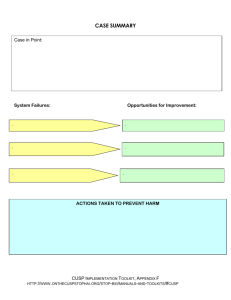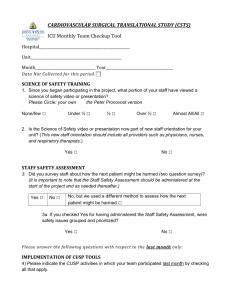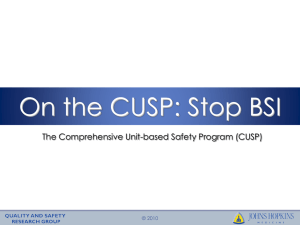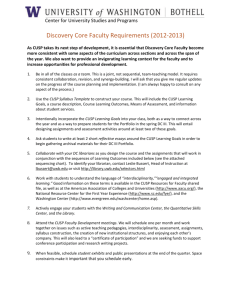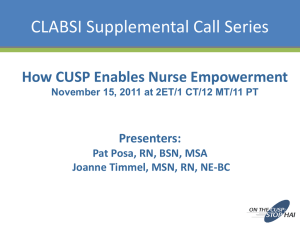GEM2012_Cusp_Tutorial
advertisement
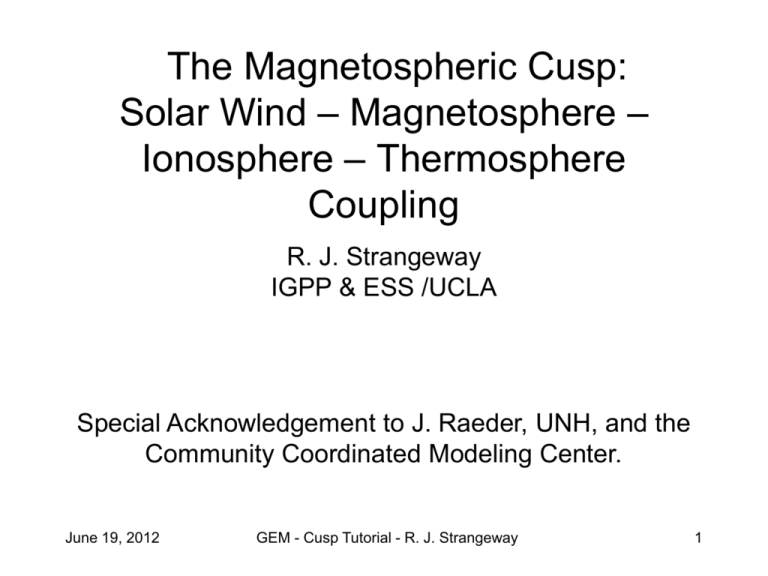
The Magnetospheric Cusp: Solar Wind – Magnetosphere – Ionosphere – Thermosphere Coupling R. J. Strangeway IGPP & ESS /UCLA Special Acknowledgement to J. Raeder, UNH, and the Community Coordinated Modeling Center. June 19, 2012 GEM - Cusp Tutorial - R. J. Strangeway 1 Outline • Introduction – why talk about the cusp? • Reconnection topology and the cusp – where is the cusp? • Cusp ion dispersion at middle altitudes – where is the reconnection? • Cusp ion dispersion at low altitudes – multiple cusps? • Field-aligned currents – Force balance and cusp dynamics • Ion outflows – Joule dissipation and electron precipitation • Neutral upwelling – Important for satellite drag • Summary June 19, 2012 GEM - Cusp Tutorial - R. J. Strangeway 2 What is so Special About the Cusp? • The cusp is the region that provides the most direct path from the solar wind to the ionosphere and thermosphere • The cusp requires an understanding of several processes: Reconnection topology and Interplanetary Magnetic Field direction effects (IMF By) Steady-state, multi-point, and time-varying reconnection Particle kinematics (time-of-flight, velocity dispersion) Field-aligned current generation Joule Dissipation – ion and neutral upwelling and outflows June 19, 2012 GEM - Cusp Tutorial - R. J. Strangeway 3 Outline • Introduction – why talk about the cusp? • Reconnection topology and the cusp – where is the cusp? • Cusp ion dispersion at middle altitudes – where is the reconnection? • Cusp ion dispersion at low altitudes – multiple cusps? • Field-aligned currents – Force balance and cusp dynamics • Ion outflows – Joule dissipation and electron precipitation • Neutral upwelling – Important for satellite drag • Summary June 19, 2012 GEM - Cusp Tutorial - R. J. Strangeway 4 Anti-parallel merging [Luhmann, 1984] B = (0,0,1) (northward) B = (0,1,0) (By only) B = (0,0,-1) (southward) B = (0,-1,-1) Luhmann et al. [1984] used Spreiter gas dynamic model to map IMF to the magnetopause Contours show regions of anti-parallel merging (up to 90˚) Crooker [1985] used superposition of IMF and Chapman-Ferraro field at magnetopause, considered component merging Cooling [2001] extended Luhmann et al. [1984] to allow for component merging June 19, 2012 GEM - Cusp Tutorial - R. J. Strangeway 5 Cooling Model – Component Merging Luhmann et al. [1984] June 19, 2012 Cooling et al. [2001] GEM - Cusp Tutorial - R. J. Strangeway 6 Outline • Introduction – why talk about the cusp? • Reconnection topology and the cusp – where is the cusp? • Cusp ion dispersion at middle altitudes – where is the reconnection? • Cusp ion dispersion at low altitudes – multiple cusps? • Field-aligned currents – Force balance and cusp dynamics • Ion outflows – Joule dissipation and electron precipitation • Neutral upwelling – Important for satellite drag • Summary June 19, 2012 GEM - Cusp Tutorial - R. J. Strangeway 7 Trattner et al. [2012] component and anti-parallel merging Characteristic signature of cusp is energy dispersed ions Plot shows Polar data at ~ 5.5 Re Mapping to magnetopause (source region) uses time-of-flight energy dispersion comparing downgoing to reflected [Onsager et al., 1990] vhdispersion T = Rr + 2R Multiple events could m be because v T =of: R • • • June 19, 2012 r Multiplel reconnection sites Time-varying reconnection Rr = 2R vh - vl High latitude andmlow-latitude reconnection (different history) GEM - Cusp Tutorial - R. J. Strangeway ( ) 8 Trattner et al. [2012], different topology By-dominated – nearly anti-parallel, multiple X-lines? June 19, 2012 Southward Bz – anti-parallel, multiple injections from same point GEM - Cusp Tutorial - R. J. Strangeway Northward Bz – component merging, extended region 9 IMF By – Hemispherical Asymmetry Østgaard et al. [2005] investigate cusp proton precipitation asymmetry using IMAGE (viewing north) and Polar (viewing south) Cusp precipitation consistent with locus of anti-parallel merging Bx contributes to hemispherical differences June 19, 2012 GEM - Cusp Tutorial - R. J. Strangeway 10 Outline • Introduction – why talk about the cusp? • Reconnection topology and the cusp – where is the cusp? • Cusp ion dispersion at middle altitudes – where is the reconnection? • Cusp ion dispersion at low altitudes – multiple cusps? • Field-aligned currents – Force balance and cusp dynamics • Ion outflows – Joule dissipation and electron precipitation • Neutral upwelling – Important for satellite drag • Summary June 19, 2012 GEM - Cusp Tutorial - R. J. Strangeway 11 Newell et al. [2007] – Forward Dispersion “FAST” DMSP Note: At low altitudes the spacecraft moves through structures June 19, 2012 GEM - Cusp Tutorial - R. J. Strangeway 12 Newell et al. [2007] – Reverse Dispersion “FAST” DMSP June 19, 2012 GEM - Cusp Tutorial - R. J. Strangeway 13 Newell et al. [2007] – Double Cusp “FAST” DMSP June 19, 2012 GEM - Cusp Tutorial - R. J. Strangeway 14 Double Cusp – Wing et al. [2001] Wing et al. [2001] argue that double cusps are because the dispersing ions come from two different reconnection sites DMSP data from Newell et al. [2007] (not the same event) June 19, 2012 GEM - Cusp Tutorial - R. J. Strangeway 15 Outline • Introduction – why talk about the cusp? • Reconnection topology and the cusp – where is the cusp? • Cusp ion dispersion at middle altitudes – where is the reconnection? • Cusp ion dispersion at low altitudes – multiple cusps? • Field-aligned currents – Force balance and cusp dynamics • Ion outflows – Joule dissipation and electron precipitation • Neutral upwelling – Important for satellite drag • Summary June 19, 2012 GEM - Cusp Tutorial - R. J. Strangeway 16 Force Balance For simplicity assume neutrals at rest (frame of reference) Ionospheric flow: Frozen-in electrons: June 19, 2012 GEM - Cusp Tutorial - R. J. Strangeway 17 IMF By-Dependent Convection Currents Convection By > 0 By < 0 Burch et al. [1985] June 19, 2012 GEM - Cusp Tutorial - R. J. Strangeway 18 Weimer [2001] FAC morphology June 19, 2012 GEM - Cusp Tutorial - R. J. Strangeway 19 FAST Orbit 8276 – Strong IMF By June 19, 2012 GEM - Cusp Tutorial - R. J. Strangeway 20 MHD FAC Predictions June 19, 2012 GEM - Cusp Tutorial - R. J. Strangeway 21 Field Topology – Shock Passage June 19, 2012 GEM - Cusp Tutorial - R. J. Strangeway 22 FAST Orbit 8284 – Double Cusp? June 19, 2012 GEM - Cusp Tutorial - R. J. Strangeway 23 Outline • Introduction – why talk about the cusp? • Reconnection topology and the cusp – where is the cusp? • Cusp ion dispersion at middle altitudes – where is the reconnection? • Cusp ion dispersion at low altitudes – multiple cusps? • Field-aligned currents – Force balance and cusp dynamics • Ion outflows – Joule dissipation and electron precipitation • Neutral upwelling – Important for satellite drag • Summary June 19, 2012 GEM - Cusp Tutorial - R. J. Strangeway 24 Ion Outflows Type 1 Type 2 Type 1 and Type 2 defined by Wahlund et al. [1992] June 19, 2012 GEM - Cusp Tutorial - R. J. Strangeway 25 Ion Outflows – Including Alfvén Waves Type 1 Type 2 Type 1 and Type 2 defined by Wahlund et al. [1992] June 19, 2012 GEM - Cusp Tutorial - R. J. Strangeway 26 Joule Dissipation and Heating Rates Plasma frame: Neutral frame: Rate of temperature increase: dTnF nmi dTi F n ni dTi F = = dt nn mn dt n in dt Minority species temperature increases more rapidly See [Strangeway, JGR, 2012] June 19, 2012 GEM - Cusp Tutorial - R. J. Strangeway 27 Outline • Introduction – why talk about the cusp? • Reconnection topology and the cusp – where is the cusp? • Cusp ion dispersion at middle altitudes – where is the reconnection? • Cusp ion dispersion at low altitudes – multiple cusps? • Field-aligned currents – Force balance and cusp dynamics • Ion outflows – Joule dissipation and electron precipitation • Neutral upwelling – Important for satellite drag • Summary June 19, 2012 GEM - Cusp Tutorial - R. J. Strangeway 28 Cusp Statistics – Knipp et al. [2011] Poynting flux statistics from DMSP Southern hemisphere is mirrorreflected about noon as a function of IMF By Events required |By| > 10 nT (a) N:By < 0, Bz < 0; (b) N:By > 0, Bz < 0 (c) N:By < 0, Bz > 0; (d) N:By > 0, Bz > 0 Red is 100 µW/m2 June 19, 2012 GEM - Cusp Tutorial - R. J. Strangeway 29 Thermospheric Response – Crowley et al. [2011] CHAMP sees strongly neutral density modulation near the cusp Modified TIME-GCM using real-time AMIE data shows enhanced densities too June 19, 2012 GEM - Cusp Tutorial - R. J. Strangeway 30 Poynting Flux Versus Neutral Density – Crowley et al. [2011] June 19, 2012 GEM - Cusp Tutorial - R. J. Strangeway 31 Small scale FACs – Lühr et al. [2004] CHAMP also sees large-amplitude small-scale FACs in the Cusp Lühr et al [2004] argue that these can significantly enhance the heating Heating rate depends on E2, But there is an issue with time scales, neutrals heat much more slowly than ions June 19, 2012 GEM - Cusp Tutorial - R. J. Strangeway 32 Summary • Reconnection topology controls the location of the cusp • There is both a high latitude (anti-parallel merging) and low latitude (component merging) source of dispersing ions – depends on IMF orientation • Field-aligned currents and Joule dissipation in the ionosphere strongly affected by IMF By – I suggest this is high latitude merging • Ion outflows and neutral upwelling both appear to be associated with Joule dissipation – question of timescales for the neutrals June 19, 2012 GEM - Cusp Tutorial - R. J. Strangeway 33
